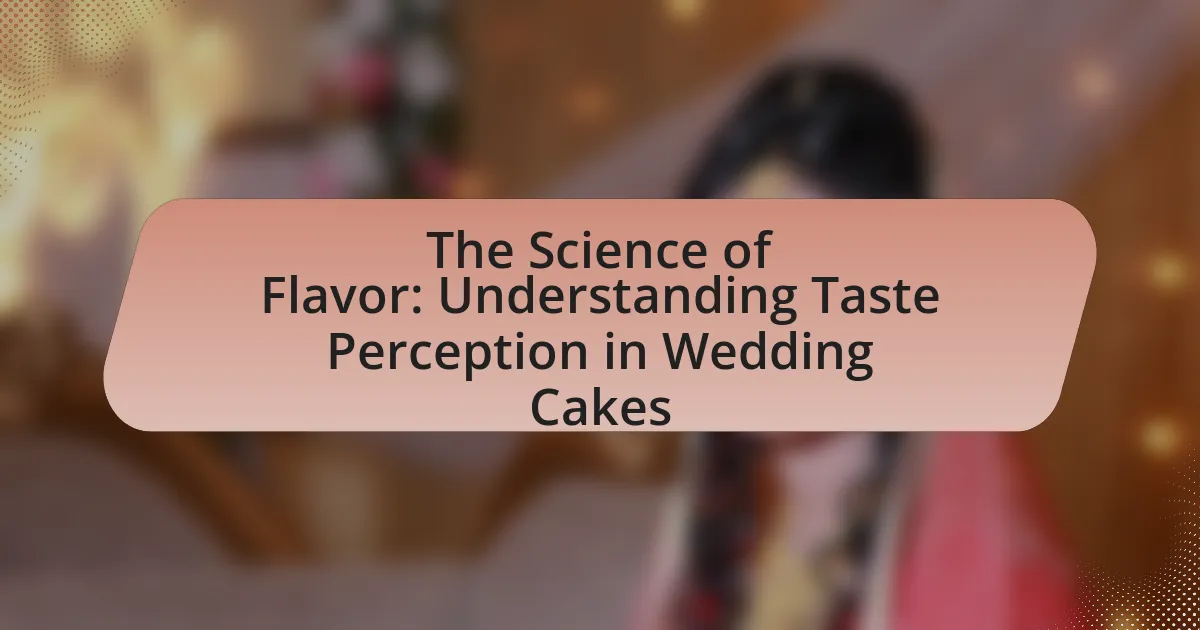The article focuses on the science of flavor in wedding cakes, emphasizing the interaction of taste, aroma, and texture that contributes to a pleasurable eating experience. It explores the five basic tastes—sweet, sour, salty, bitter, and umami—and highlights the significant role of aroma in flavor perception. Key components such as sweetness, acidity, fat, and aroma are discussed, along with how different ingredients influence flavor perception and the importance of understanding flavor for effective wedding cake design. Additionally, the article addresses the physiological aspects of taste perception, the impact of cultural background on flavor preferences, and best practices for optimizing flavor in wedding cakes.

What is the Science of Flavor in Wedding Cakes?
The science of flavor in wedding cakes involves the interaction of taste, aroma, and texture to create a pleasurable eating experience. Flavor perception is primarily influenced by the five basic tastes: sweet, sour, salty, bitter, and umami, which are detected by taste buds on the tongue. Additionally, aroma plays a crucial role, as it contributes to approximately 80% of what we perceive as flavor; this is due to the olfactory receptors in the nasal cavity that detect volatile compounds released during the cake’s baking process.
For example, the Maillard reaction, which occurs when sugars and amino acids react under heat, enhances the complexity of flavors in cake, resulting in a richer taste profile. Furthermore, the balance of ingredients, such as the type of flour, sugar, and fats used, affects both the texture and flavor, making the cake moist or dry, dense or light. Studies have shown that the combination of these elements can significantly influence consumer preference, with well-balanced flavors leading to higher satisfaction rates among wedding cake tasters.
How does taste perception influence the enjoyment of wedding cakes?
Taste perception significantly influences the enjoyment of wedding cakes by determining how flavors are experienced and appreciated. The combination of sweetness, texture, and flavor complexity in wedding cakes directly affects the overall sensory experience, leading to heightened enjoyment. Research indicates that the human palate is sensitive to various taste modalities, including sweet, sour, salty, bitter, and umami, which interact to create a unique flavor profile. For instance, a study published in the journal “Food Quality and Preference” by A. S. Drewnowski and A. Almiron-Roig highlights that sweetness is a primary driver of preference in desserts, including cakes. This suggests that the balance of sweetness and other flavor components can enhance or detract from the overall enjoyment of wedding cakes, making taste perception a crucial factor in their appreciation.
What are the key components of flavor in wedding cakes?
The key components of flavor in wedding cakes include sweetness, acidity, fat, and aroma. Sweetness primarily comes from sugar, which not only provides the primary taste but also enhances other flavors. Acidity, often derived from ingredients like citrus or buttermilk, balances sweetness and adds complexity. Fat, typically from butter or oils, contributes to mouthfeel and richness, while aroma, influenced by vanilla, chocolate, or spices, plays a crucial role in flavor perception, as the sense of smell significantly impacts taste. These components work together to create a harmonious flavor profile that is essential for an enjoyable wedding cake experience.
How do different ingredients contribute to flavor perception?
Different ingredients contribute to flavor perception by providing distinct taste compounds, aromas, and textures that interact with the sensory receptors in the mouth and nose. For example, sugars in cake enhance sweetness, while acids from ingredients like lemon juice or buttermilk add tartness, creating a balanced flavor profile. Additionally, fats from butter or oils carry flavor compounds and provide a creamy mouthfeel, which can enhance the overall perception of flavor. Spices and extracts, such as vanilla or almond, introduce aromatic compounds that significantly influence flavor perception through olfactory pathways. Research indicates that the combination of these elements can create complex flavor experiences, as demonstrated in studies on flavor interactions in baked goods, highlighting the importance of ingredient selection in achieving desired taste outcomes.
Why is understanding flavor important for wedding cake design?
Understanding flavor is crucial for wedding cake design because it directly influences the overall guest experience and satisfaction. A well-designed wedding cake not only looks appealing but also needs to deliver a harmonious balance of flavors that complement the occasion. Research indicates that flavor perception is a complex interplay of taste, aroma, and texture, which means that a cake’s flavor profile can significantly affect how it is received by guests. For instance, a study published in the journal “Food Quality and Preference” highlights that flavor combinations can enhance enjoyment and create memorable experiences, reinforcing the importance of thoughtful flavor selection in wedding cake design.
How can flavor combinations enhance the overall cake experience?
Flavor combinations can significantly enhance the overall cake experience by creating a more complex and enjoyable taste profile. When different flavors are paired, they can complement or contrast with each other, leading to a richer sensory experience. For instance, the combination of sweet and salty flavors, such as chocolate cake with a hint of sea salt, can elevate the taste by balancing sweetness with savory notes. Research indicates that flavor interactions can stimulate multiple taste receptors, enhancing the perception of flavor intensity and satisfaction. This complexity not only engages the palate but also creates memorable experiences, making cakes more appealing during events like weddings.
What role does cultural background play in flavor preferences?
Cultural background significantly influences flavor preferences by shaping individuals’ exposure to and experiences with different tastes. For instance, people from cultures that traditionally use spices, such as Indian or Mexican cuisines, often develop a preference for bold and complex flavors, while those from cultures with milder culinary traditions may favor simpler, less intense tastes. Research indicates that these preferences are formed through early dietary experiences and socialization, which dictate what flavors are deemed enjoyable or acceptable. A study published in the journal “Appetite” by A. Drewnowski and A. Almiron-Roig highlights how cultural factors and personal experiences contribute to the development of taste preferences, demonstrating that flavor choices are not merely individual but are deeply rooted in cultural contexts.

What are the physiological aspects of taste perception?
Taste perception involves the physiological processes that occur when taste stimuli interact with taste receptors on the tongue. These receptors, known as taste buds, are located within papillae and are responsible for detecting five primary taste modalities: sweet, sour, salty, bitter, and umami. When food molecules dissolve in saliva, they bind to these receptors, triggering a signal that is transmitted via cranial nerves to the brain, specifically the gustatory cortex, where the perception of taste is processed. Research indicates that the average human tongue contains approximately 2,000 to 8,000 taste buds, each capable of sensing different taste qualities, which contributes to the complexity of flavor perception.
How do taste buds function in perceiving flavors?
Taste buds function by detecting chemical substances in food, which are then translated into specific flavor perceptions. Each taste bud contains sensory cells that respond to five basic tastes: sweet, sour, salty, bitter, and umami. When food molecules dissolve in saliva, they interact with these sensory cells, triggering electrical signals that are sent to the brain. Research indicates that humans have approximately 2,000 to 8,000 taste buds, each capable of recognizing different flavor profiles, thus contributing to the overall taste experience. This process is essential for flavor perception, as it allows individuals to distinguish between various tastes, enhancing the enjoyment of foods, including wedding cakes.
What types of taste sensations are recognized by the human palate?
The human palate recognizes five primary taste sensations: sweet, sour, salty, bitter, and umami. These sensations are detected by taste buds on the tongue, which respond to specific chemical compounds in food. For instance, sweet tastes are typically associated with sugars, sourness with acids, saltiness with sodium ions, bitterness with various compounds often found in plants, and umami with amino acids like glutamate. This classification is supported by research in sensory science, which has established these five categories as fundamental to human taste perception.
How does the brain process flavor information from the taste buds?
The brain processes flavor information from the taste buds through a complex interaction involving the gustatory system and the olfactory system. When taste buds detect chemical compounds in food, they send signals via cranial nerves to the brainstem, which relays this information to the thalamus. The thalamus then transmits the signals to the primary gustatory cortex, where the perception of taste occurs. Additionally, flavor perception is enhanced by olfactory input; the olfactory receptors in the nasal cavity detect volatile compounds released from food, which are integrated with taste signals in the orbitofrontal cortex. This integration allows for the rich experience of flavor, as evidenced by studies showing that taste and smell work together to create a unified perception of flavor.
What factors affect individual taste perception?
Individual taste perception is influenced by genetic factors, environmental influences, and psychological aspects. Genetic variations, such as those affecting taste receptor genes, can determine sensitivity to specific flavors, with studies indicating that about 25% of the population are supertasters, who experience tastes more intensely. Environmental factors, including cultural background and exposure to different foods, shape preferences and aversions, as seen in research showing that individuals from different cultures have varying taste preferences based on their dietary habits. Psychological factors, such as mood and past experiences, also play a significant role; for instance, positive associations with certain foods can enhance taste perception, while negative experiences can lead to aversions.
How do genetics influence taste preferences?
Genetics significantly influence taste preferences by determining an individual’s sensitivity to certain taste compounds. For example, variations in the TAS2R38 gene affect the perception of bitterness, leading some people to find foods like Brussels sprouts or coffee unpalatable, while others enjoy them. Research published in the journal “Nature” by Kim et al. (2003) demonstrated that individuals with different genotypes of this gene have distinct taste preferences, which can shape dietary choices and overall food enjoyment. This genetic basis for taste perception underscores the biological factors that contribute to individual differences in flavor preferences, particularly in contexts such as wedding cake flavors.
What environmental factors can alter taste perception?
Environmental factors that can alter taste perception include temperature, humidity, and the presence of other flavors or aromas. Temperature affects taste sensitivity; for example, colder temperatures can dull sweetness while enhancing bitterness. Humidity influences the volatility of aromatic compounds, which can enhance or diminish flavor perception. Additionally, the presence of other flavors can create interactions that modify the overall taste experience, such as the way salt can enhance sweetness. These factors are supported by research indicating that sensory perception is not solely dependent on the food itself but is significantly influenced by the surrounding environment.

How can bakers optimize flavor in wedding cakes?
Bakers can optimize flavor in wedding cakes by using high-quality ingredients, balancing sweetness with acidity, and incorporating complementary flavors. High-quality ingredients, such as pure vanilla extract and fresh fruits, enhance the overall taste profile. Balancing sweetness with acidity, for instance by adding citrus zest or a touch of yogurt, can prevent the cake from being overly sweet and create a more complex flavor. Additionally, incorporating complementary flavors, such as pairing chocolate with coffee or almond with vanilla, can elevate the cake’s taste. These methods are supported by culinary principles that emphasize the importance of ingredient quality and flavor balance in baking.
What techniques can be used to enhance flavor in cake recipes?
To enhance flavor in cake recipes, bakers can utilize techniques such as incorporating flavor extracts, using fresh ingredients, and adjusting the balance of sweet and savory elements. Flavor extracts, like vanilla or almond, provide concentrated flavor that can elevate the overall taste profile. Fresh ingredients, such as fruits or herbs, contribute natural flavors and aromas, making the cake more vibrant. Additionally, balancing sweetness with a touch of salt or acidity can enhance the perception of flavor, as demonstrated by the culinary principle that salt amplifies sweetness and acidity can brighten flavors. These techniques are supported by culinary science, which emphasizes the importance of ingredient quality and balance in flavor development.
How does the choice of frosting impact the overall flavor experience?
The choice of frosting significantly impacts the overall flavor experience by enhancing or contrasting the cake’s inherent flavors. Different frostings, such as buttercream, cream cheese, or fondant, introduce varying levels of sweetness, creaminess, and texture, which can either complement or overpower the cake’s taste. For instance, a rich chocolate buttercream can intensify the chocolate flavor of a cake, while a tangy cream cheese frosting can provide a refreshing contrast to a sweet vanilla cake. Studies in flavor perception indicate that the balance of sweetness and acidity in frostings can alter taste experiences, making the choice of frosting crucial for achieving a desired flavor profile in wedding cakes.
What are the best practices for flavor pairing in wedding cakes?
The best practices for flavor pairing in wedding cakes involve balancing complementary and contrasting flavors to enhance the overall taste experience. For instance, pairing rich flavors like chocolate with lighter flavors such as vanilla or fruit can create a harmonious balance. Additionally, incorporating seasonal ingredients can elevate the cake’s appeal; for example, using fresh berries in summer or spiced flavors like cinnamon in fall.
Research indicates that flavor pairing can be guided by the principles of taste perception, where sweet flavors often pair well with acidic or bitter notes to create depth. A study published in the “Journal of Culinary Science & Technology” highlights that successful flavor combinations often rely on the synergy between sweet, salty, sour, and bitter elements, which can be strategically utilized in wedding cake design.
What common mistakes should bakers avoid when creating wedding cakes?
Bakers should avoid several common mistakes when creating wedding cakes to ensure flavor and structural integrity. One major mistake is not properly leveling the cake layers, which can lead to uneven stacking and a lopsided appearance. Additionally, bakers often overlook the importance of using high-quality ingredients; inferior ingredients can negatively impact flavor and texture. Another frequent error is neglecting to account for the cake’s environment, such as temperature and humidity, which can affect frosting consistency and cake stability. Lastly, failing to communicate effectively with the couple about their preferences and dietary restrictions can result in a cake that does not meet expectations. These mistakes can compromise the overall success of the wedding cake, impacting both its aesthetic and taste.
How can over-sweetening affect flavor perception?
Over-sweetening can significantly distort flavor perception by masking other taste components, such as acidity and bitterness. When a food or beverage is excessively sweet, the sweetness can dominate the palate, leading to an inability to detect more subtle flavors that contribute to the overall taste experience. Research indicates that high sugar levels can inhibit the perception of sour and bitter tastes, which are essential for a balanced flavor profile. For instance, a study published in the journal “Food Quality and Preference” found that participants rated products with lower sugar content as more flavorful due to the enhanced perception of other taste elements. This demonstrates that over-sweetening not only alters the intended flavor balance but can also diminish the overall enjoyment of the food.
What are the consequences of using low-quality ingredients?
Using low-quality ingredients in wedding cakes can lead to poor flavor, texture, and overall quality. Low-quality ingredients often lack the essential compounds that contribute to desirable taste and mouthfeel, resulting in cakes that are bland or unappealing. For instance, inferior flour may not provide the necessary gluten structure, leading to a dense or crumbly texture, while low-grade sugars can affect sweetness and moisture retention. Additionally, the use of artificial flavorings instead of natural extracts can produce an artificial taste that detracts from the cake’s overall enjoyment. Studies have shown that ingredient quality directly influences consumer satisfaction, with high-quality ingredients correlating with better taste perception and preference in baked goods.
What are some tips for achieving the perfect flavor balance in wedding cakes?
To achieve the perfect flavor balance in wedding cakes, it is essential to combine complementary flavors and textures. Start by selecting a base flavor, such as vanilla or chocolate, and then incorporate contrasting elements like fruit, nuts, or spices to enhance complexity. For instance, pairing a rich chocolate cake with a tart raspberry filling creates a pleasing contrast that elevates the overall taste experience. Additionally, consider the sweetness level; using a less sweet frosting can balance a sweeter cake, ensuring that no single flavor overwhelms the palate. Research indicates that flavor perception is influenced by the balance of sweet, sour, salty, and bitter components, which can be adjusted to create a harmonious blend.
